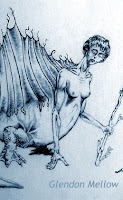Chemically speaking, it is similar to diamond. Pencils have never been made of lead, but graphite was once known as "white lead", or plumbago which is Latin for lead ore, so that's why we have the modern confusion. There's some interesting, but not fully comprehensive stuff on good ol' Wikipedia about pencils and the magical material, graphite. Little "sheets" of it rub off and onto the paper with friction, leaving smudgeable marks. Graphite will not harm humans. Unless you do that annoying flicking the pencil between all your fingers, in which case it's game on.

The last couple of Artwork Mondays, I've been revamping an old concept of mine for a Dimtrodon Sphinx (at right), which was a detail of another drawing.
I'm using a .3mm mechanical pencil, as well as a more standard 2mm pencil for the larger areas. Both are packing HB leads; a lot of artists like softer (think B for black) or lighter (think H for hard) leads, but I like how easy it is to get a hold of HB. It's in the middle of the spectrum, and easy to shop for. The grey piece of putty-stuff is my wonderful kneadable eraser. Kneadable erasers can be shaped to erase in any nook and cranny, and leave no little eraser bits behind on the page. Brilliant. I used the same materials on the original (above), which I tinted blue using Photoshop for the sake of whimsy.

This has been a busy week for me and I did not make a lot of progress on this piece. However, I did decide to go with a slightly different reference photo than what I started with. It's always important to try different lighting, and when I took the model photos, I took two of each pose, one with the flash, and one with natural light coming from the window behind and to the right of the model. This week, I made a decision to switch to the latter.
I was reluctant at first, since this model has an excellent back, and the flash-lit photo showed that more clearly. However, being backlit can lend the piece the lighting of a full moon, or perhaps lightning which works better at making this beautiful half-human, half-dimetrodon sphinx look like a dangerous predator.
Needing a background, I started roughing in some rocks, and a scraggly tree to the left. I may try to make the sail-fin on the back partially translucent, with the silhouette of the rocky background darkening the fin near the spine.
I'm also debating with myself about whether or not this homo-synapsid will have hair; I've begun sketching a second sail on her neck and head. The sail makes her more "other" and alien, and hair makes her more beautiful and accessible for most viewers to immediately engage in. I'm currently leaning toward hair whipping in the wind.
Although the leading theories say that dimetrodon, edaphosaurus and the much-later-on spinosaurus may have had sails for thermal-regulation, I believe they must also have been there for sexual display, much like a peacock's tail. In nature, large flamboyant features with no immediately obvious use often turn out to be the result of sexual selection pressure. If this is so, what colour or pattern would be present? Since anything I choose will be speculation, there is a lot of freedom here.

In the inspiring book, The New Dinosaurs, by Dougal Dixon, artist Philip Hood depicted a creature called a Dingum, a small hopping, fuzzy creature with a spiky frill and a sail-fin on it's back. The interesting feature the artist added, was a pattern like that of a monarch butterfly on the sail-fin. As I say, there is a lot of freedom for an artist here.
Because the synapsids like Dimetrodon are more closely related to mammals than any other modern beasties, I'm leaning toward some sort of mammalian pattern to make it interesting. Perhaps an orca? Doubtful it would need that type of camouflage, since orcas, like penguins and herring gulls have evolved dark on the dorsal so animals looking down through the water at them are less likely to see them against the depths, and vice versa when looking up at their backlit ventral side. However, that type of colouration seems exciting, even if a cheetah pattern or tiger stripes are more likely. It's just that leopard print is like, so late 90's.
Orcas, baby. I'll see if I can finish this drawing in time for Artwork Monday next week.
- -
All original artwork on The Flying Trilobite Copyright to Glendon Mellow. The contents of this blog are under a Creative Commons Licence. See sidebar for details.


 I think it is a more dynamic pose than the one I mused with
I think it is a more dynamic pose than the one I mused with 






 (I could go on and on about an 1840 lithograph by
(I could go on and on about an 1840 lithograph by 



